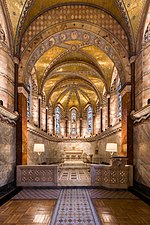Cleveland Hall, London
EngvarB from September 2013Former buildings and structures in the City of Westminster
Cleveland Hall was a meeting hall in Cleveland Street, London that was a centre of the British secularist movement between 1861 and 1878, and that was then used for various purposes before becoming a Methodist meeting hall.
Excerpt from the Wikipedia article Cleveland Hall, London (License: CC BY-SA 3.0, Authors).Cleveland Hall, London
Cleveland Street, London Fitzrovia (London Borough of Camden)
Geographical coordinates (GPS) Address Nearby Places Show on map
Geographical coordinates (GPS)
| Latitude | Longitude |
|---|---|
| N 51.520574 ° | E -0.138792 ° |
Address
Cleveland Street
Cleveland Street
W1T 4JL London, Fitzrovia (London Borough of Camden)
England, United Kingdom
Open on Google Maps









